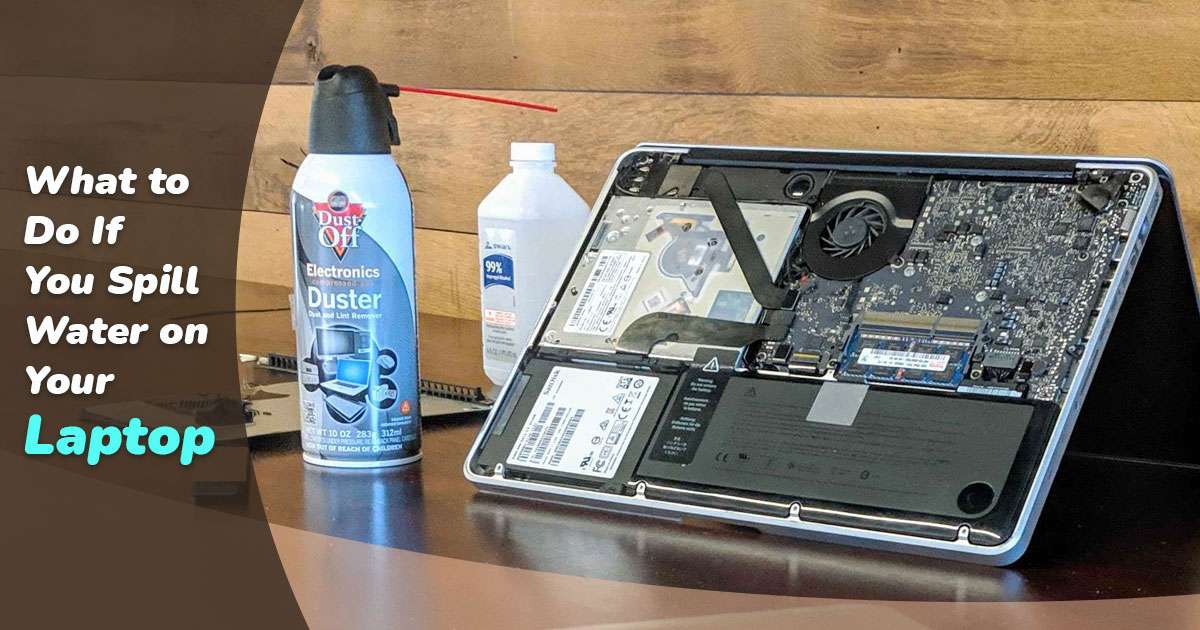What to Do If You Spill Water on Your Laptop: Essential Steps for Recovery

These days, laptops are like an extension of ourselves. They hold our work, our memories, and, let’s be honest, our binge-watching habits. So, when disaster strikes in the form of spilled water on your laptop, it’s not just a technical mishap; it feels personal.
One of the primary causes of damage to malfunctioning notebooks among end users of U.S. companies in 2009. A significant 66% of respondents identified liquid spills as a contributing factor to the damage.
Knowing what to do if you spill water on your laptop can mean the difference between salvaging your precious device and facing costly repairs or replacement. Therefore, it’s crucial to act swiftly and decisively to minimize damage and maximize the chances of a successful recovery.
Immediate Response: Acting Fast Could Save Your Laptop
The moment you spilled water on your laptop, time was of the essence. Your quick response could mean the difference between a small problem and a big catastrophe.
- Power Down Immediately: The first rule when you spill water on your laptop is to shut it down instantly. No ifs, or buts. Cutting power helps to prevent short circuits that can cause serious damage. Taking this action right away is very important to protect your device and lower the risk of damage that can’t be fixed. Remember, every second counts in the race against potential water damage to your laptop.
- Disconnect and Dry: Unplug everything from your laptop—power cords, USB drives, external mice, you name it. Then, grab a soft, lint-free cloth to gently dab and soak up as much spilled liquid as possible on the laptop. Remember, gentle pats are better than aggressive rubbing. This methodical approach ensures that you’re effectively removing moisture from all nooks and crannies of your laptop, reducing the likelihood of lingering water damage.
- Flip It Over Turning your laptop upside-down helps to drain any water that’s made its way inside. This position allows gravity to do its thing, pulling the water away from the internal components where it can do the most harm. By promptly flipping your laptop, you’re taking proactive steps to prevent the water from seeping deeper into the delicate electronics, mitigating potential damage along the way.
- Battery Removal: If your laptop design allows, remove the battery. This step further reduces the risk of electrical damage. For models with non-removable batteries, just ensure the device stays off. By removing the battery, you’re cutting off any potential power source that could exacerbate the effects of water exposure, safeguarding your laptop’s internal circuitry from further harm.
- Let It Dry: Patience is key. Leave your laptop in a dry, well-ventilated area for at least 24-48 hours. The A-frame position is recommended for effective drying. If you want to use external heat sources, like hair dryers, don’t. They can do more damage. Giving your laptop enough time to dry naturally will make sure that any wetness that is still there evaporates completely. This lowers the risk of corrosion and electrical problems in the future.
After the Storm: Assessing and Repairing
Once you’ve given your laptop time to dry, the moment of truth arrives. It’s time to see if your quick actions have paid off.
- Visual Inspection: Before you power on, inspect your laptop for any signs of water damage. Residue or discoloration can indicate areas where the liquid has affected the components. This thorough examination allows you to identify any areas of concern before powering up your device, enabling you to take appropriate action to address the damage promptly and prevent further issues.
- The Power On Test: Reattach the battery (if you removed it) and plug in your laptop. Crossing your fingers, press the power button. If it boots up, breathe a sigh of relief, but keep an eye out for any unusual behavior. This critical step in the recovery process provides insight into the extent of the damage and allows you to determine whether additional repairs or precautions are necessary to ensure the continued functionality of your laptop.
- Data Backup: Successfully turned on your laptop? Great! Now, back up your data immediately. Water damage can have delayed effects, so it’s wise to secure your important files as soon as possible. By prioritizing data backup, you’re safeguarding your valuable information against any potential data loss or corruption that may result from lingering water damage or subsequent hardware issues.
- Professional Assessment: Even if everything seems to be working fine, a check-up with a professional can uncover any potential long-term damage. They can offer solutions to prevent future problems and ensure your laptop is in top shape. Getting a professional opinion gives you peace of mind and lets you deal with any problems that aren’t obvious at first, protecting your laptop’s health and performance in the long run.
Preventing Future Disasters
Having survived spilled water on your laptop once, you’ll want to take steps to avoid a repeat performance. Here are some preventative measures:
- Keep Liquids Away: It sounds obvious, but keeping drinks at a safe distance from your laptop is the easiest way to prevent spills. Accidents happen, but why not minimize the risks?
- Invest in Protection: Consider purchasing a waterproof keyboard cover or a laptop case. With these extras, you can protect against spills even more.
- Regular Backups: Make it a habit to back up your data regularly. You can back up your laptop regularly to an extra hard drive or the cloud. This will save you a lot of trouble if your laptop gets damaged in any way, not just from spills.
What should you do if you spill water on your laptop? You’ve Got This!
Many of us dread the stress that comes from spilling water on our laptops. But with these steps and safety measures, you’ll be ready to handle the problem if it happens. Remember that the most important things to do are to turn off your laptop right away, dry it carefully, and give it enough time to dry out. If you do these things ahead of time, these proactive steps can greatly increase the chances of your laptop surviving water damage.
When something spills on your laptop, being ready and knowing what to do can make all the difference. Remember that things aren’t always as bad as they seem, take a deep breath, and follow these steps. With some luck and a lot of wait time, you and your PC can make it through the storm. Stay dry, and may your notebook last for many more days of work.

